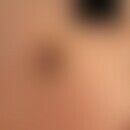Synonym(s)
HistoryThis section has been translated automatically.
Ahlfeld, 1883; Sweeper, 1907
DefinitionThis section has been translated automatically.
Hormonally triggered, acute disease of late pregnancy with reversible cholestasis and accompanying massive, uncontrollable itching without primary skin symptoms. There are only scratch excoriations.
You might also be interested in
Occurrence/EpidemiologyThis section has been translated automatically.
In Central Europe, 0.2-2.0% of pregnancies occur; in Chile and Bolivia the incidence is between 9-28%, in China between 1.2-6.0%. The incidence is higher in the winter months than in summer (lowered vitamin D concentrations are described as a risk factor).
EtiopathogenesisThis section has been translated automatically.
Hereditary impairment of bile formation may be caused by mutations of transport mechanisms at the bile capillary membrane. A relationship with progressive familial intrahepatic cholestasis is suspected, in which phospholipid transfer from the inner to the outer side of the membrane is disturbed, resulting in disturbed formation of mixed micelles in the bile.
Defects in at least 7 genes have been detected so far. For example, mutations of the MDR3 gene (coding for phosphatidylcholine translocase), the ABCB4 gene (syn. MD3 gene: multidrug resistance), the ATP8B1 gene, the ABCB11 gene (liver-specific transporter that transports bile acids into the bile ducticulus).
A participation of the Bile Acid Export Pump (BSEP) is also assumed. The transfer of bile acids in serum causes considerable itching.
Some authors also postulate a selenium deficiency and increased intestinal permeability (leaky good) as manifestation factors.
In a larger registry study, a correlation between chronic HCV infection and the occurrence of hepatic pregnancy cholestasis could be shown (Marschall HU et al. 2013).
ManifestationThis section has been translated automatically.
Mostly occurring in the third trimester. Older pregnant women (>35 years) and multi-para are more frequently affected.
ClinicThis section has been translated automatically.
LaboratoryThis section has been translated automatically.
Liver values are usually unremarkable. Always elevated are the fasting total bile acids in serum (> 11 µmol/l [normal value: 0-6 µmol/l]). Increased may be gamma-GT, alkaline phosphatase (always increased in pregnancy, therefore not meaningful alone), bilirubin (direct). Hyperbilirubinemia in approx. 10-20%.
HistologyThis section has been translated automatically.
Direct ImmunofluorescenceThis section has been translated automatically.
Complication(s)This section has been translated automatically.
External therapyThis section has been translated automatically.
In many cases, cold showering brings significant relief (possibly several times a day). Afterwards, apply menthol(menthol cream 5%) or polidocanol-containing topicals (e.g. R200 R197, Optiderm). Polidocanol-containing shaking mixtures or polyacrylic gels provide temporary relief. The gel base in particular has a pleasant cooling and itch-soothing accompanying effect. If these therapeutic approaches are not successful, low-dose (0.5%) hydrocortisone emulsions can be used R123.
Radiation therapyThis section has been translated automatically.
Internal therapyThis section has been translated automatically.
Ursodesoxycholic acid 15 mg/kg bw/day is currently considered the therapy of choice. (Off-label use; only approved for primary biliary cirrhosis).
If there is no response to ursodesoxycholic acid, rifampicin may be considered as a second-line therapy.
If the symptoms are very pronounced, the use of tranquilizers such as diazepam 5-10 mg/day (e.g. 2 times/day 1 tablet of Valium® 5) or sedative antihistamines such as hydroxyzine (Atarax) 25-75 mg/day should be considered after the first trimester under strict indication (off-label use).
Caution! During the perinatal phase these drugs must always be discontinued!
Progression/forecastThis section has been translated automatically.
The itching disappears a few days after delivery and may reappear in the next pregnancy. Thus, childbirth is the causal "therapy" of pregnancy cholestasis. The risk of recurrence of pregnancy scholestasis in another pregnancy is 45-70%. The risk of gallstones is three times higher.
LiteratureThis section has been translated automatically.
- Amato L et al (2003) A case of chronic herpes gestationis: persistent disease or conversion to bullous pemphigoid? J Am Acad Dermatol 49: 302-307
- Ambros-Rudolph CM (2010) Specific pregnancy dermatoses. Dermatologist 61: 1014-1020
- Deinlein E et al (1983) Immunopathological investigations in herpes gestationis. Dermatologist 34: 6-9
- Kehrer E (1907) The importance of icterus in pregnancy for mother and child. Clinical and experimental investigations. Arzh Gynek 81: 129
- Kemper T et al (1989) Herpes gestationis when taking an oral contraceptive. Act Dermatol 15: 121-123
- Kremer AE et al (2017) Intrahepatic cholestasis of pregnancy:Rare but important. Dermatologist 68:95-102.
- Lin MS et al (2001) Herpes gestationis. Clin Dermatol 19: 697-702
- Marshall HU et al (2013) Intrahepatic cholestasis of pregnancy and associated hepatobiliary disease:
apopulation-based cohort study. Hepatology 58:1385-1391 - Wever S et al (1995) Herpes gestationis. Clinical spectrum and diagnostic possibilities. dermatologist 46: 158-164
Incoming links (10)
Gravidar pruritus; Hydrocortisone emulsion hydrophilic 0.5-1; Menthol cream 5%; Polidocanol gel, hydrophilic 5% (nrf 11.117.); Polidocanol zinc oxide shaking mixture 3/5 or 10% (nrf 11.66.) [white/skin coloured].; Pregnancy dermatosis, atopic; Prurigo gestationis; Prurigo gravidarum; Recurrent cholestasis of pregnancy; Ursodesoxycholic acid;Outgoing links (16)
Antihistamines, systemic; Diazepam; Emulsions; Hydrocortisone; Hydrocortisone emulsion hydrophilic 0.5-1; Hydroxycin; Menthol; Menthol cream 5%; Pemphigoid gestationis; Polidocanol; ... Show allDisclaimer
Please ask your physician for a reliable diagnosis. This website is only meant as a reference.




